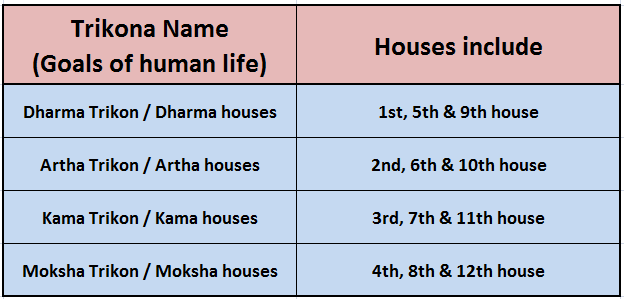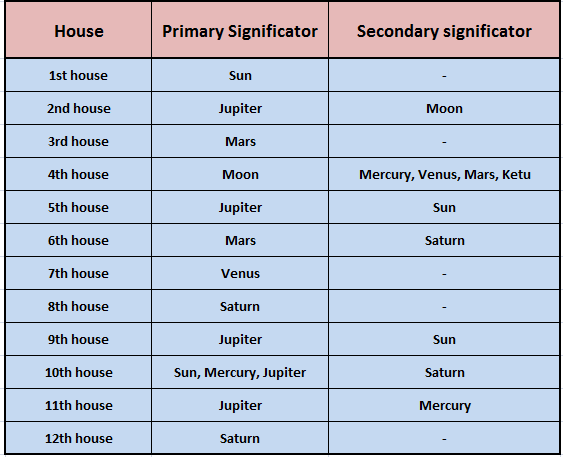In the last 2 parts of our discussion on the houses, we get to know many things about houses like, various house systems in astrology, the correct house system to follow etc.
In this post, we will discuss about different categorization of the 12 houses along with the basic meaning of each house.
If you haven’t read the first and second part of this discussion then I recommend you to read them first for better understanding of this topic.
Houses as “Bhavas”
In Vedic astrology, a house is called as “Bhava”.
The word “Bhava” means “Thoughts” and it is very obvious to name the houses as “Bhava” because each house possesses some kind of “Thought” in it and they represent certain things.
The word “Bhava” means “Thoughts” and it is very obvious to name the houses as “Bhava” because each house possesses some kind of “Thought” in it and they represent certain things.
Like the Rashis (Zodiac signs) and Grahas (Planets), they also represent certain things and thus each house (Bhava) has a special name associated with it that conveys its inner thought or, the related things that it represents.
In the below table (fig-1), the 12 houses along with their special name and the things that they represent are given -:
 |
| Fig-1 : Bhava & their special names along with some basic things that they represent |
Special names for house lords
As we know that, the house lord is the planet who rules over
the zodiac sign present in the mid-point of the house.
The lord of a certain house controls the effects of that house and as the houses have some special names so, the lord (Planet) who controls the house also gets a special name.
The special names given to various house lords are given in the below table (fig-2)-:
 |
| Fig-2 : Bhava & Special names for bhava lords |
Concept of “Bhavat-Bhavam”
With
the help of astrological chart and other required data , an astrologer can know
not only about the native but also about his/her life , relatives , bosses ,
children , grandparents & grandchildren and even about the wife, boss ,
relatives of their grandparents & grandchildren and lot more.
All such minute details can't be found directly but, by using the concept of "Bhavat bhavam" or, "House to house relationship" and for deep analysis of these minute details, an astrologer may refer to divisional charts also.
Although "bhavat bhavam" concept can reveal many things about a single house still, each house uniquely represents certain related things that is briefly discussed in the above table (fig-2) and will be discussed precisely in our later posts.
{We will discuss the “Bhavat-Bhavam” concept
and all the things that a house can represent through this very concept in our
future posts}
Good & Evil houses
In Vedic astrology, the 12 houses are categorized in
different groups according to the nature of the things that they represent.
Generally, there are 6 such groups in which we can arrange the houses according to the nature of the things that they represent. They are -:
- Kendra houses
- Trikona houses / Dharmasthana houses
- Dusthana houses / Triksthana houses
- Trishadaya houses
- Upachaya houses
- Marakasthana houses
Kendra houses
The 1st house, 4th house, 7th
house and 10th houses are considered as the “Kendra” houses.
These houses are the most auspicious houses as they represent some of the most important and fundamental areas of life like nature, character, mother, father, spouse, marriage, status, relations etc.
Trikona houses
The 1st house, 5th house and 9th
house comes under “Trikona” houses.
These houses are considered as auspicious as they bring spirituality, goodness, generosity, knowledge & well-being to the native (if these houses and their lords are not afflicted). Hence, placement of planets in these houses is considered good.
These houses are considered as auspicious as they bring spirituality, goodness, generosity, knowledge & well-being to the native (if these houses and their lords are not afflicted). Hence, placement of planets in these houses is considered good.
Therefore, the “Trikona” house is also known as “Dhramasthan” which means “The righteous place”.
Dusthana houses
The 6th house, 8th house and 12th
house are considered as the “Dusthana” houses or, evil houses.
These houses and their lords bring difficulties, suffering, loss, anxiety, worries, obstacles, diseases, debts, confinements, isolation, enemies, lawsuits, injuries, accidents, sudden events, surgeries and death like experiences in the native’s life.
These houses and their lords bring difficulties, suffering, loss, anxiety, worries, obstacles, diseases, debts, confinements, isolation, enemies, lawsuits, injuries, accidents, sudden events, surgeries and death like experiences in the native’s life.
These three houses are also called as “Triksthana” houses.
8th house is generally considered bad for the placement of any planet.
Trishadaya houses
The 3rd house, 6th house and 11th
house comes under “Trisadaya houses”.
These houses are also malefic houses and the most malefic house among these, is the 11th house because it represents “Greed” which is also the source of anger, desires & wrong deeds.
These houses are also malefic houses and the most malefic house among these, is the 11th house because it represents “Greed” which is also the source of anger, desires & wrong deeds.
11th house is generally considered good for the placement of any planet.
Upachaya houses
The 3rd house, 6th house, 10th
house and 11th house are called as “Upachaya houses” and considered
as the best placement for natural malefic planets like Saturn, Rahu, Mars and
Sun (Without any further affliction).
These houses gradually become effective as the person gets older slowly. So, they are like “increasing/growing” houses that became effective in the life of the native with age.
The planets in these houses may give sound or, a little difficult time in initial stage and with time they grow stronger. Benefic planets like Jupiter, Moon, Venus and Mercury don’t produce favorable results in these houses (in general).
Strong “Upachaya” houses or, relation between the planets owning “Upachaya” houses can give sudden and miraculous results in terms of material growth in life.
Among all the “Upachaya” houses, the 10th house is the strongest as it represents work, profession, karma, job, career etc. which are very much essential for fulfillment of all other desires.
Maraka Sthana houses
The 12th from any house is considered as the
“loss of the things” that the house represents. In Vedic astrology, the 3rd
house and the 8th house are the houses of “longevity” and thus 12th
from these houses falls in the 2nd house and the 7th
house respectively.
Therefore, the 2nd house and 8th house
are called as “Maraka Sthana” or, “House of death”. Planets occupying or,
owning these houses can bring death life sufferings, health disturbances and
even death during their period (Dasha or, antar-dasha etc.).
Malefic planets in the 7th house are not considered as good at all as it produces negative lust.
The below table (fig-3) summarizes the categorization of different houses according to the nature of the things that they represent.
 |
| Fig-3 : Categorization of houses on the basis of their nature |
The “Upachaya” houses and “Trikona” houses support and enhance
the results of “Kendra” houses. Both the “Kendra” and “Trikona” houses have the
1st house in common, thus, among all the 12 houses, the 1st
house (Ascendant) is considered as the strongest house.
Houses & their motives
As per Vedic literature, human life has four types of
motive or, goals in life. They are -:
- Dharma (righteous duty & religion)
- Artha (Wealth)
- Kama (Desires)
- Moksha (Salvation/emancipation)
The 12 houses can also be grouped in these 4 categories and they influence the planet(s) placed in it with its inherent motive.
As we have 3 houses in each category, hence they are also
known as “Dharma triangle”, “Artha triangle”, “Kama triangle” and “Moksha
triangle” because we have study the 3 houses of a category simultaneously to
get into any kind of prediction and also by joining the mid-point of the 3
house of any category, they form a triangle.
The below table (fig-4) shows the houses and their
respective inherent motive (or, different goals of human life) -:
 |
| Fig-4 : Houses and their inherent motive |
The planetary positions and dignity in “Dharma triangle” shows the native’s tendency towards the religion and righteous deeds and that of in “Artha triangle” shows their tendency to gain & accumulate wealth in life.
The word “Kama” means “Desire”. Therefore; for an ascetic person, God is the most desirable object and for an artist or, entertainer; gaining fame in the world might be the most desirable thing. So, “Kama” can be interpreted as a driving force which shapes the future of a person according to the nature, mode & intensity of it.
The planetary positions & dignity in “Kama triangle” shows how well the native can achieve his/her desires.
Similarly, the planetary placements & dignities in “Moksha triangle” shows the extent up to which the native can get the complete mastery over a subject because, “Moksha” is the ultimate state and goal of human life and thus represents crowning attitude in any subject.
Bhava Karaka (Significator of Houses)
Some planets became the significator of certain houses
(Bhavas) due to the similar characteristics between the house and the planet.
The planet who became the significator of a house is called as “Karaka” of that house or, “Bhava Karka”.
The houses and their respective “Bhava Karaka” are given in the below table (fig-5) -:
 |
| Fig-5 : House & their significator(s) |
If the “Bhava Karaka” (Mostly, the primary significator) of a “bhava (house)” is placed in that “Bhava (house)” itself then, it generally destroys the effect of that “bhava (house)”. Hence, such type of placement is not beneficial to the native.
With this, we conclude our discussion on “Houses in Vedic
astrology” but, in our future discussion with title “Understanding the houses”,
we will discuss more on “Bhavas (Houses)” through a series of posts.
Thank you
(Powered by Quantum X)
In the below image; we have given our contact details. So, if you want consultation from us then you can just contact us here-:
Contact details
(you can send us Whatsapp message on the given contact number for consultation purpose)
|
All other details like our address, fee structures, different services, mode of transaction etc. will be provided to you if you are interested in getting consultation from us.
Make your connection strong with us
Like & follow our Facebook page-: Astro X - Facebook

In our simple life, love plays a very specific role. Now we are able to make your love life healthy and it has no space for any type trouble. These all are possible with the help of PEACEFUL HOME SOLUTION. He helped me cast a spell that brought my long lost lover back within 48hours who left me for another woman. you can also contact him on ( peacefulhome1960@zohomail.com ) or WhatsApp on: ( +2348104102662 ) . and be happy forever like am now with his experience.
ReplyDelete